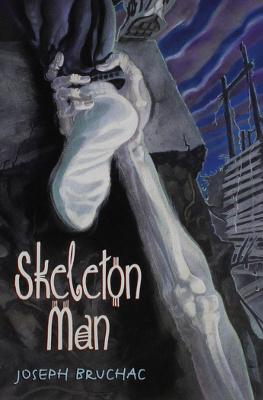 Series: Skeleton Man, #1
Series: Skeleton Man, #1
First Published: 1st August, 2001
Genre: Middle Grade Horror / Novel
Available: Amazon.com | Amazon UK
When Molly’s parents disappear, she’s sent to live with an uncle she’s never seen before. He reminds her of the story of the Skeleton Man, but will anyone believe her?
The story starts after Molly’s parents have vanished, but it flashes back to previous events such as her parents not coming home and meeting her uncle. Her uncle reminds her of the old Mohawk story of the Skeleton Man. This is about a man who likes the taste of human flesh, so eats all of his own until he’s only a skeleton. Then he starts eating his family. Her uncle is pale, thin, and she’s never seen him eat. But more importantly, she’s sure he doesn’t have good intentions towards her, whatever those might be.
I liked the theme of using stories to understand the world. Thinking about the Skeleton Man gives Molly a framework for dealing with what’s happening around her. The stories in her dreams help her decide what she’s going to do. This is also reinforced with modern stories, as Molly feels comforted by the songs from musicals sung by her teacher, Ms. Shabbas.
Though what’s happening at her uncle’s house is creepy, there’s also horror in what happens outside. Molly has her concerns dismissed by the adults who should be protecting her. Her only ally is her teacher. Ms. Shabbas believes something is wrong, without expecting Molly to be use exactly the right words. It’s clear Molly is frightened and that’s enough. But the people with the real power to act are reluctant to listen. This will be relatable for many children, who’ve tried to go to adults only to have their concerns brushed aside.
Ms. Shabbas has her own obstacles when it comes to being heard. Her concerns about Molly are not taken particularly seriously, even though she’d know the children in her class and would be in the good position to realise something isn’t right. No one outright says she’s being too imaginative, as happens to Molly, but there is that polite attempt to not listen to what she’s saying if at all possible. This is subtle, as the only indicator given is that Ms. Shabbas has an afro, but I certainly took that as being a black woman making it harder to be heard.
Race and culture is touched on in other ways. One reason Molly is sure she won’t be believed is the Skeleton Man isn’t a shared story with the adults she’s approaching. Molly takes her own dreams very seriously, but is aware that talking about them won’t go down well. She’s also very critical of her own appearance, such as finding her dark hair ugly and wanting to dye it blonde. It reminded me of wanting to straighten my hair when I was a child, because I’d already picked up on my hair not being deemed acceptable. Children shouldn’t face these pressures telling them non-white features are ugly, but they do, so Molly’s criticism of herself was unfortunately very plausible.
There is a reference to the idea of being crazy as a potential cause of the uncle’s behaviour. The adults involved make a specific link between people who are non-neurotypical and survivors of trauma as being likely to act this way. Molly pushes this aside as unlikely. But the link is still being made between evil acts and craziness, in a way that some readers will take away as being the probable cause.
Outside of my concerns on the evil and crazy link, I enjoyed the story. It creates that unsettling feel right from the start. As well as the potential supernatural angles, it also touches on some rather more everyday (if not any less horrifying) issues.
The reading difficulty of the book is aimed at lower middle grade. It’s a very short novel with relatively easy words. The edition I read had pictures by Sally Wern Comport to break up the text. Note that it does have horror themes and cannibalism references.